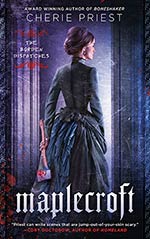
![]() ZachReviews
ZachReviews
10/3/2014
![]()
What do you get when an eldritch disease invades the town of fall river, and the only answer is the sharpened edge of an axe? You get Cherie Priest's Maplecroft. At first appearance, Priest's novel may come off as one of those supernatural/historical/classical novels that swept the nation a few years ago. Novels like Pride and Prejudice and Zombies or Abraham Lincoln, Vampire Hunter where the primary story of a known event, like the events of Pride and Prejudice, are interrupted by brain eating monsters or blood sucking fiends. Maplecroft is less of that kind of mashup of two very different things, and is more of a love letter to Lizzie and Emma Borden, putting them as two people trying to protect, not harm.
Maplecroft is told in a mostly non-linear fashion, as each chapter represents a letter or diary entry from one of the many characters. The perspective switches between that of Lizzie Borden, her doctor, a scientist that has been in contact with Emma Borden, and other characters connected to the Borden sisters. The story focuses on the events after the Borden murders and retell the story of what happened with a Lovecraftian-twist. Early on we learn that Lizzie didn't murder her parents out of anger or rage, but rather was fighting off the creatures that they had become due to a mysterious infection. The infection at first appears contained, but soon begins springing up in the town, making Lizzie and her axe the only answer to stopping the spread.
Priest's writing style throughout the novel stays consistent with 19th century vernacular and keeps accurate to the overall timeline the book sets. Many of the details she includes, like when Lizzie is in a fight with a monster and complains of the tightness of her constricting corset, or the doctor of the Borden's talking about his experience with typhoid fever, represent many truths that would've held accurate to the time period. Priest obviously has done her research in terms of the historical accuracy of the novel's setting. It of course takes its creative liberties, besides the monsters, Lizzie and Emma Borden's interest in biology isn't chronicled anywhere in the known history of the Borden sisters. However, the mystery of what occurred at Maplecroft Estate is still up for many to speculate about, as very few people have records of what the Borden sisters did when they moved to the house.
The aspect of the novel that drew me most to it was the Lovecraftian style of horror. The monsters in the book are almost indescribable in nature, something held true to the cosmic horror style of Lovecraft's mythos. The Gothic setting makes for a nice change of pace in comparison to H. P. Lovecraft's focus on the early 20th century. While the book doesn't contain the usual amounts of social subtext that is usually associated with the works of H. P. Lovecraft, the use of cosmic horror entities makes for a very enjoyable read. You get the same feeling of dread and intrigue that you would get if they were described out right, but it's the lack of description that makes them almost all the more terrifying; to think something is so horrifying, that it is indescribable is adds terror to itself.
What sets the novel the most apart from other works like that of Lovecraft and makes it less of a "Lizzie Borden Vs. Cthulhu" story, is the way the characters are handled. The characters never feel like they could be swapped. There is never a moment when I thought "I could easily replace Lizzie Borden with Abraham Lincoln, and say 'this is the same story'". The characters were made for this story, they fit. Lizzie Borden's portrayal as an analytical, yet determined attitude creates an almost Holmes-like persona, almost comparable to that of Madame Vastra of the recent Doctor Who seasons. She is intelligent, willing, and has Victorian sensibilities about how she handles the monsters that invade Fall River.